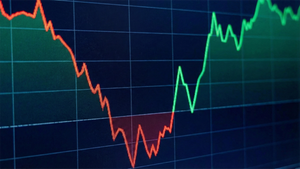
The financial markets are once again demonstrating their volatile nature, with two prominent companies, Deere & Co. (NYSE: DE) and Tapestry (NYSE: TPR), experiencing significant stock declines following their latest earnings reports. Despite some aspects of their quarterly results exceeding analyst expectations, both companies issued cautious full-year outlooks, sending ripples of concern through their respective sectors and the broader market. This immediate reaction underscores investor sensitivity to future guidance, even when past performance shows strength, highlighting a prevailing atmosphere of uncertainty driven by macroeconomic factors and specific industry headwinds.
Disappointing Outlooks Trigger Market Sell-Off
The recent earnings season has delivered a stark reminder that strong past performance can be overshadowed by a conservative future outlook. Deere & Co., the global agricultural machinery giant, saw its shares plummet after it lowered its full-year profit forecast. While the company reported better-than-expected quarterly earnings, driven by robust demand in its agriculture and construction segments, its revised guidance reflected concerns over slowing demand in key markets and potential impacts from trade tensions. Similarly, Tapestry, the parent company of luxury brands like Coach, Kate Spade, and Stuart Weitzman, faced a sharp decline in its stock price. Despite reporting solid quarterly results, the company's cautious full-year revenue and profit projections, particularly citing a challenging environment in China and ongoing promotional activities, spooked investors who had anticipated a more optimistic recovery in luxury spending.
The immediate market reaction was swift and decisive. Investors, already wary of a potential economic slowdown and persistent inflationary pressures, interpreted the lowered outlooks as a red flag. For Deere, the concerns revolve around the cyclical nature of agricultural equipment demand, which is heavily influenced by commodity prices and farmer income, as well as the lingering threat of tariffs impacting global trade. For Tapestry, the luxury retail sector is grappling with shifting consumer spending habits, intense competition, and the critical importance of the Chinese market, where economic uncertainties continue to weigh on consumer confidence. These developments highlight a broader trend where companies, facing an unpredictable global economic landscape, are opting for more conservative guidance, leading to immediate investor backlash even when current performance is stable.
Navigating the Aftermath: Potential Winners and Losers
The fallout from Deere & Co.'s and Tapestry's revised outlooks is likely to create a ripple effect, distinguishing potential winners from losers within their respective industries. In the agricultural machinery sector, while Deere's cautious stance might signal a broader slowdown, it could also prompt investors to re-evaluate competitors. Companies with more diversified revenue streams or those less exposed to the specific headwinds cited by Deere might be perceived as relatively safer bets. However, if Deere's outlook is indicative of a systemic downturn in agricultural equipment demand, then most players in the sector, including smaller manufacturers and suppliers of components, could face headwinds. The impact on farmers, who are Deere's primary customers, is also crucial; a slowdown in equipment sales could reflect tighter margins or reduced investment capacity among agricultural producers, potentially affecting the entire agricultural value chain.
In the luxury retail space, Tapestry's struggles, particularly in the crucial Chinese market, could benefit rivals who demonstrate greater resilience or have a stronger foothold in other growing regions. European luxury conglomerates like LVMH Moët Hennessy Louis Vuitton (EPA: MC) or Kering (EPA: KER), with their diverse brand portfolios and global reach, might be seen as more robust, although they are not immune to similar macroeconomic pressures. Conversely, smaller, less established luxury brands or those heavily reliant on the same challenging markets as Tapestry could find themselves under increased pressure. The broader trend of consumers becoming more discerning with discretionary spending, coupled with the rise of resale markets and sustainable fashion, also poses a long-term challenge to traditional luxury players, forcing them to innovate and adapt their strategies to remain competitive.
Industry Impact and Broader Implications
The recent earnings reports from Deere & Co. and Tapestry are not isolated incidents but rather symptomatic of broader industry trends and macroeconomic shifts. For the industrial and agricultural sectors, Deere's lowered outlook underscores the sensitivity of capital expenditure to global economic conditions and trade policies. This event fits into a pattern where companies with significant international exposure are grappling with geopolitical tensions, supply chain disruptions, and fluctuating commodity prices. It could signal a potential deceleration in global industrial activity, impacting not only direct competitors like CNH Industrial (NYSE: CNHI) but also suppliers of raw materials, components, and logistics services. Historically, downturns in agricultural equipment sales have often preceded broader economic slowdowns, making Deere's guidance a closely watched indicator for the health of the global economy.
In the luxury retail segment, Tapestry's challenges highlight the ongoing volatility in consumer discretionary spending, particularly in key growth markets like China. This trend is part of a larger narrative where luxury brands are navigating a post-pandemic landscape characterized by inflation, shifting consumer preferences towards experiences over goods, and increased competition from direct-to-consumer brands. The regulatory environment, especially concerning trade tariffs and intellectual property rights, also plays a significant role, adding layers of complexity to international operations. The situation with Tapestry could prompt other luxury brands to re-evaluate their market strategies, diversify their geographical footprint, and invest more heavily in digital channels and personalized customer experiences to mitigate risks associated with concentrated market exposure or economic downturns.
What Comes Next
Looking ahead, both Deere & Co. and Tapestry face critical periods that will test their strategic agility. In the short term, investors will closely monitor any further updates on their full-year outlooks, particularly as new economic data emerges and trade negotiations evolve. For Deere, the focus will be on how effectively it can manage inventory levels, adapt production to changing demand, and leverage its technology and precision agriculture solutions to maintain market share. The company might explore strategic acquisitions or divestitures to optimize its portfolio and enhance resilience against market fluctuations. For Tapestry, the immediate challenge lies in revitalizing growth in key markets, particularly China, and effectively managing promotional activities without eroding brand equity. This could involve targeted marketing campaigns, product innovation, and a deeper engagement with local consumer trends.
In the long term, both companies will need to consider more fundamental strategic pivots. Deere may need to accelerate its transition towards a more service-oriented model, leveraging its vast installed base and data analytics capabilities to generate recurring revenue streams less susceptible to cyclical downturns in equipment sales. This could involve expanding its offerings in precision agriculture services, autonomous solutions, and sustainable farming technologies. Tapestry, on the other hand, might need to further diversify its brand portfolio, explore new geographic markets beyond its traditional strongholds, and potentially engage in strategic partnerships or collaborations to enhance its competitive edge in a rapidly evolving luxury landscape. Both companies will also need to navigate the broader macroeconomic environment, including interest rate policies, inflation, and geopolitical stability, which will undoubtedly shape their operational and financial performance in the coming years.
Conclusion
The recent stock plunges experienced by Deere & Co. and Tapestry serve as a potent reminder of the market's forward-looking nature and its sensitivity to future guidance. Despite reporting solid quarterly results, their cautious outlooks, driven by concerns over slowing demand, trade tensions, and challenging market conditions, triggered significant investor sell-offs. This event underscores the prevailing uncertainty in the global economy, where even established market leaders are not immune to the pressures of macroeconomic headwinds and shifting consumer behaviors.
Moving forward, investors should closely watch how these companies adapt their strategies to navigate the challenging environment. For Deere, the focus will be on its ability to manage cyclical demand and leverage technological advancements to maintain its leadership position. For Tapestry, the key will be its success in revitalizing growth in critical markets and adapting to evolving luxury consumer trends. The broader implications extend to their respective industries, signaling potential slowdowns in industrial capital expenditure and continued volatility in discretionary consumer spending. The coming months will be crucial in determining whether these companies can regain investor confidence and demonstrate resilience in the face of ongoing economic uncertainties.




